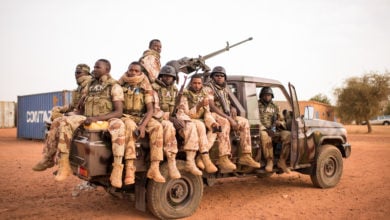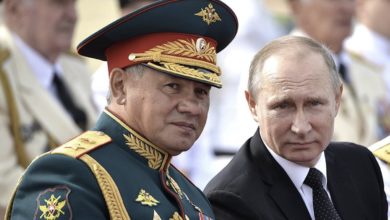|

Boris Yeltsin
|
Boris Yeltsin died on April 23 at the age of 76. He was best known for presiding over the 1991 capitalist counterrevolution in the Union of Soviet Socialist Republics.
For that reason, few Russian workers mourned his death. His funeral ceremonies were attended by imperialist politicians from the United States and Europe, along with representatives of the new super-rich capitalist class in Russia.
During the 1980s, a “reform” tendency emerged in the Communist Party of the Soviet Union. This tendency was politically nourished by decades of class conciliation with U.S. imperialism and a non-revolutionary orientation to the working class in the socialist countries. When Mikhail Gorbachev declared the policies of “glasnost”—what amounted to in practice of an opening to pro-capitalist intellectuals and politicians—and “perestroika”—the dismantling of key components of the Soviet workers’ state—the “reform” tendency more and more oriented away from the most basic measures defending the gains of socialist planning.
Soviet socialism was in obvious need of reform. The problems of privilege, inequality, bureaucratism and mismanagement were apparent. The Soviet socialist expansion that was unprecedented in the 20th century had slowed noticeably in the 1980s.
But instead of instituting a reform program aimed at tackling its problems by making the Soviet Union more socialist based on communist principles, Gorbachev and Yeltsin raced to strengthen the hand of pro-capitalist forces in the economic and political sphere. They also sought to deepen the country’s relationship with U.S. imperialism.
Boris Yeltsin rose through the ranks of the Communist Party of the Soviet Union as part of this “reform”-oriented tendency. When he became president of the Russian Federation from 1991 to 1999, Yeltsin presided over the breakup of the Soviet Union, the dissolution of the Communist Party of the Soviet Union, the selling off of publicly owned property, the destruction of the planned economy and the opening of Russia to Western capitalism.
He fundamentally destroyed every aspect of the Soviet legal and political institutions that did not harmonize with this counterrevolution. His government dismantled all significant social and economic rights that workers retained as conquests of the 1917 revolution.
To overcome resistance from political forces that challenged his moves, he continuously expanded his executive powers. He dissolved any governmental bodies that stood in his way. In 1993, he ordered Russian tanks to open fire on the Russian parliament, which was resisting the course he was taking.
For all this, the corporate press in the United States memorialized Yeltsin as a great reformer and democrat—even while acknowledging his “crude” and “erratic” leadership style.
Marilyn Berger, writing a glowing obituary in the April 24 New York Times, admits, “In the chaos that accompanied the transition from the centralized economy [Yeltsin] had inherited from the old Soviet Union, most people saw their circumstances deteriorate. Inflation became rampant, the poor became poorer, profiteers grew rich, the military and many state employees went unpaid and criminality flourished.”
In fact, these negative socio-economic trends did not just accompany the immediate transition to capitalism. They have become basic features of Russian life to this day.
Capitalist apologists want to blame the current misery facing tens of millions of workers across the former Soviet Union on the 1917 socialist revolution. They ignore the fact that the first attempt to build socialism lifted a poor and underdeveloped Russia to the position of a world power.
The conquests of the Russian Revolution
For the entire duration of the so-called Cold War, from the end of World War II in 1945 to the destruction of the Soviet Union in 1991, anti-Soviet propaganda was the unofficial state-sponsored religion of the United States. The U.S. people were bombarded with every form of distortion about life in the Soviet Union in order to discredit the project of socialist construction. Few had even the slightest understanding of the basic social and economic rights enjoyed by every person in the Soviet Union.
Every worker in the Soviet Union was guaranteed the constitutional right to a job. The minimum wage was roughly one and a half times greater than consumption levels, and therefore corresponded to the actual cost of living. All citizens had access to free health care.
Male workers could retire at 60 years old with half pay, while women retired at 55. Workers were legally guaranteed the right to a month’s paid vacation starting with their very first year of employment, and the beautiful Black Sea resort locations previously only available to the aristocratic elite were opened up at low cost to the broader population.
Women workers had the right to a year of paid maternity leave after childbirth. Child care, too, was free, and sprawling networks of day care centers and cultural centers for children existed throughout the Soviet Union. Education was free at all levels, from kindergarten through post-doctoral programs.
The challenges facing Soviet development
The Soviet Union was not able to guarantee these basic rights because it was a rich country. Its general economic level and level of productivity were significantly lower than that of the developed capitalist economies.
The Russian Revolution inherited a poor peasant-based economy, battered not only by the First World War but a devastating civil war from 1919-1921, which returned much of the countryside to the darkest days of czarist rule. During World War II, the Soviet Union bore the brunt of the fight against fascism. It faced off with 80 percent of the entire Nazi military machine—with battles fought almost entirely within Soviet borders. In the process, the Soviet Union lost 27 million people, almost an entire generation of young men, before turning back the German advance.
This crippling war was immediately followed by the so-called Cold War with the United States. The U.S. monopoly on the atomic bomb and obvious willingness to use it posed an immediate threat to the existence of the Soviet Union. The Soviet government was compelled to commit ever-growing sectors of the economy to military development.
The impact of the Cold War arms race on the Soviet economy cannot be overstated. The Soviet Union sustained yearly growth rates that enabled it to become the second biggest economy in the world. But by 1977, its real gross national product was still only one-third that of the United States.
Matching the United States weapon-for-weapon constituted a huge drain on Soviet technological and economic development. Every ruble spent on military expenditures needed to defend the country came at the expense of even greater improvements in the quality of living for the working class. In addition, the military spending magnified longstanding degenerative political tendencies within the Soviet leadership.
Despite these serious economic limitations and distortions, the economy continued to grow. The basic social rights of the population remained intact and inalienable. The Soviet economy never experienced a period of economic recession—that is, negative growth—between 1921 and 1985. In fact, the boom-and-bust of the capitalist business cycle—with all its attendant miseries for the working class—was avoided altogether.
The socialist economy: a higher stage of development
How was the Soviet Union able to provide for the population despite its unfavorable economic and military situation? The Russian Revolution eliminated the capitalist class and the profit motive from the economy. Instead of producing commodities for an uncertain market where some individuals get very rich while others go bankrupt or are forced to live by their wits, the Soviet system was organized according to social needs.
The engine that drove the economy was an economic plan, not the uncoordinated profit seeking of individual competing capitalists. Instead of capitalists accumulating for their own benefit the great wealth produced by the workers, the products of social labor were distributed and allocated in an organized way, according to an overall economic plan.
In a market-driven economy, capitalists frantically produce more and more commodities and use the latest technologies to beat out their competitors. Eventually, more commodities are produced than can be sold for a profit, businesses contract and workers are laid off. This is known as a crisis of overproduction—an absurdity unique to capitalist economies. The unemployed workers are then unable to purchase commodities—a process known as underconsumption—setting into motion a destructive economic process leading to recession or depression.
The Soviet planned economy eliminated this anarchy of competitive capitalism. Whether or not they planned well or planned poorly, the economy’s structure eliminated the wasteful and painful phenomena of overproduction, underconsumption, mass layoffs and recessions.
The Yeltsin years
|

May Day 2007 anti-capitalist demonstration in Moscow, ‘Our poverty is your future’
Photo: Itar-Tass/Anatoly Kuzyarin
|
All this progress was overturned by Yeltsin’s counterrevolution. Bankrolled by the United States and the International Monetary Fund, Yeltsin implemented a “shock therapy” privatization program.
From 1991 to 1995, 116,000 state-owned enterprises were privatized in Russia. Raw materials and whole sections of the country’s industrial infrastructure were sold off to the highest bidder.
This breaking apart of previously socialized property has been a complicated process, which U.S. Marxist Sam Marcy compared to “trying to break up a tremendous ocean liner into small boats and sell them at a profit.” The Russian government has been forced at times to slow the process and renationalize certain large companies.
But the general trend is unmistakable. By 2003, 23 business groups owned 57 percent of Russia’s total industrial production. The country recently announced its 60th billionaire.
How did life change for the Russian workers?
Unemployment, unheard of in the Soviet Union until 1990, skyrocketed to 10 percent by 1995. The poverty rate was near 20 percent in 2004, according to World Bank figures.
The real purchasing power provided by the Russian minimum wage sunk dramatically, as Yeltsin dismantled longstanding price controls on basic goods. By 1997, the real average income of working-class families was 25 to 30 percent what it was in 1990. That year, a U.N. agency announced that 100 million people had sunk below the poverty line in Russia.
This process was replicated in Belarus and Poland, where poverty rates shot up to 73 percent and 50 percent, respectively.
Between 1990 and 1994, the country’s death rate increased an astounding 40 percent. Male life expectancy fell from 63.8 years to 57.7, and among women, from 74.3 years to 71.3—a phenomenon unprecedented during peacetime in modern history. Thirteen years later, these figures remain at 59.1 and 73—far below their Soviet levels.
After cardiovascular disease, the leading causes of death were accidents, suicides and homicides. Alcohol-related deaths tripled in the first four years of the counterrevolution.
Whereas the streets of the Soviet Union were known as generally safe, crime is now an enduring feature of Russian life. The situation became especially grim for women, whose wages fell from 70 percent that of men in 1990 to 40 percent in 1997. Women suffered from violent crime in shocking numbers, with the number of women murdered increasing sevenfold from 1990 to 1997. Prostitution and human trafficking of women, unheard of in Soviet days, is now rampant.
The role of the Russian working class
In March 1991, the people of the Soviet Union voted by a three-to-one margin to retain the Union of Soviet Socialist Republics. Yet, Gorbachev and Yeltsin—in tandem with counterrevolutionaries from other Soviet republics—quickly moved forward to undermine the influence of the Soviet Union.
|

A Soviet factory worker in 1976—one of millions who made socialist construction possible.
Photo: B. Chervyakov/Itar-Tass KRT
|
A desperate August 1991 attempt to unseat Yeltsin by Communist Party leaders opposed to the rapidly unfolding Gorbachev-Yeltsin counterrevolution was defeated. Yeltsin used the defeat to paint himself as a democrat boldly taking on the country’s conservative bureaucratic leadership. Riding this wave, he unconstitutionally dissolved the Soviet Union nine months later.
In 1993, Yeltsin faced stiff opposition from the Congress of People’s Deputies and the Supreme Soviet, where elements of the Communist Party who opposed the counterrevolution still had some influence. In response, he ordered those bodies dissolved by decree. When they refused to disband, Yeltsin ordered tanks to shell the Russian parliament.
Tens of thousands of anti-Yeltsin demonstrators took to the streets in a spontaneous uprising, which was put down with massive military force. According to official sources, 187 were killed. Unofficial sources put the number closer to 1,500.
It was the deadliest street fighting since 1917. But again, no effective and widely trusted organization existed to channel this anger into a sustained revolutionary movement.
In the 1996 elections, popular opposition to Yeltsin’s counterrevolution resulted in a first-round electoral victory for the Communist Party candidate. In the period leading up to the run-off, however, Yeltsin received millions of dollars and a public relations team from the United States. Threatening the population with potential civil war if the Communists were re-elected, he bankrolled his way to victory.
Throughout the Yeltsin counterrevolution, the Russian working class was atomized. No effective workers’ organization came forward to defend the planned economy from his clique and the intrusion of foreign capitalists.
The Communist Party, which had come to power in 1917 as a revolutionary party, had gone through decades of political degeneration as a ruling party. Privilege and bureaucratism became dominant factors that prevented the party from maintaining its close connection as a respected vanguard of the working class.
The Soviet political establishment split into two basic camps. One side, led by Yeltsin, favored the full-scale restoration of capitalist property relations. The other sought to defend the socialist character of the planned economy.
The wing of the Soviet bureaucracy that opposed Yeltsin and Gorbachev proved unable to organize and lead the workers against the forces of the counterrevolution. They were incapable of organizing an effective defense that could call the masses of Russian workers into the streets to defend their revolution.
The fight over the direction of the country took place primarily in the highest layers of power, where the imperialist-backed bureaucrats around Yeltsin held the most influence. The masses of people remained tragically on the sidelines, largely confused and passive, as the counterrevolution vanquished one of the most formidable states in the world. As a class, the workers of the Soviet republics lost their significant social achievements.
Yeltsin is now dead, but the counterrevolution he presided over remains as his criminal legacy. This legacy opened the door for the period of U.S. imperialism’s unchecked expansion and bravado.
It also opened a period of tremendous political challenges for the world’s working classes, from which revolutionary forces are only now beginning to emerge. The challenge of the Russian working class and their allies around the world will be to bury Yeltsin’s legacy in the tomb it deserves—the dustbin of history.






